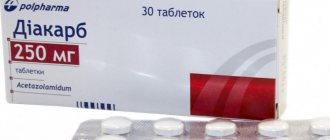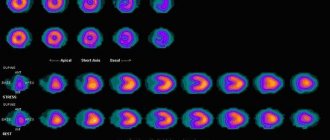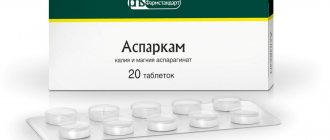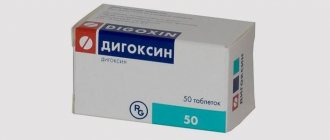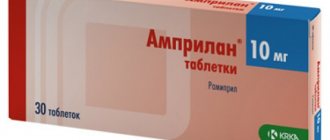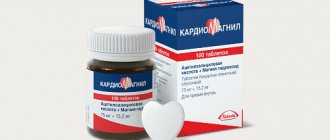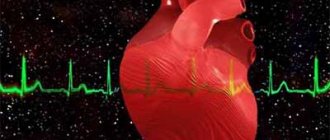Description of medications
To understand the principle of action of taking Asparkam and Diacarb together, you should familiarize yourself with the main points of the instructions for their use.
Compound
- The active ingredient of the diuretic Diacarb is acetazolamide. Its amount in one tablet is 250 mg.
- Asparkam is a complex drug containing 2 active components. Each tablet contains: potassium aspartate – 175 mg;
- magnesium aspartate – 175 mg.
Mechanism of action
- Acetazolamide in Diacarb has a diuretic effect. It inhibits the action of the enzyme carbonic anhydrase, thereby increasing the excretion of water by the kidneys. Magnesium, sodium and potassium ions are washed out with the liquid. It also reduces intracranial and intraocular pressure, and the symptoms of epilepsy (a neurological disease manifested by seizures) disappear.
- Asparkam, the active components of which are magnesium and potassium, is intended to replenish the deficiency of these substances in the body. The drug also stabilizes the functioning of the cardiovascular and nervous systems, improves metabolic processes, and affects the formation and development of bone tissue.
Indications
For Diakarb:
- glaucoma – increased intraocular pressure;
- swelling;
- epilepsy;
- mountain sickness is a pathological condition caused by changes in pressure during ascents.
For Asparkam:
- myocardial infarction (death of a certain area of the heart due to severe disruption of its blood supply);
- lack of potassium and magnesium in the body, their deficiency in nutrition;
- heart failure;
- treatment with cardiac glycosides.
Contraindications
Common to the two drugs:
- hypersensitivity to components;
- kidney and liver failure;
- dysfunction of the adrenal glands.
Diacarb should also not be taken if:
- diabetes mellitus;
- pregnancy and breastfeeding;
- hypokalemia (potassium deficiency);
- acidosis (increased blood acidity);
- uremia – poisoning of the body with its own metabolic products (nitrogen and others).
Additional contraindications to the use of Asparkam are:
- disorders of the urinary process (anuria, oliguria);
- cardiogenic shock (severe failure of the left ventricle of the heart);
- atrioventricular block (impaired conduction of electrical impulses in the heart muscle);
- low blood pressure;
- excess potassium with magnesium;
- severe muscle weakness;
- hemolysis - breakdown of red blood cells;
- amino acid metabolism disorders.
Side effects
Diacarb can cause reactions such as:
- cramps and muscle weakness;
- hypokalemia;
- skin redness, itching;
- hives (rash);
- noise in ears;
- myopia;
- hematopoietic disorders;
- disturbances of touch;
- diarrhea;
- vomiting, nausea;
- allergy.
Taking Asparkam can also provoke undesirable effects:
- dry mouth;
- muscle weakness;
- nausea and vomiting;
- flatulence (formation of gases in the intestines);
- stomach ache;
- stomach and intestinal bleeding, ulcers;
- diarrhea;
- increased fatigue;
- feeling of heat;
- disturbances of cardiac activity and vascular tone;
- decreased blood pressure;
- hyperkalemia.
Diacarb tablets 250 mg are sold in packs of 30 pieces. The price depends on the manufacturer and can vary between 249-273 rubles.
Asparkam is also a tablet product. Its cost is determined by the amount of medicine in the package:
- 20 tab. – 48 rub.;
- 56 tab. – 81 rubles;
- 60 tablets – 52 rubles.
There are a number of features.
Diakarb
The active ingredient is acetazolamide. A diuretic that acts by inhibiting the activity of the carbonic anhydrase enzyme. Acts on the proximal convoluted tubules of the kidneys, increasing the excretion of sodium and potassium cations in the urine. Alkalizes urine, accelerating the elimination of acidic metabolic products, medications, and toxicants. Reduces intracranial pressure in intracranial hypertension.
It is used for diseases accompanied by edematous syndrome: heart failure with anasarca, hydropericardium, dropsy (ascites) against the background of liver cirrhosis, glaucoma. Indications for use also include epilepsy, alkalosis, and mountain sickness.
It has a weak diuretic effect, therefore it is often used in combination with other diuretics (Furosemide, etc.). May cause acidosis.
Diacarb is used to treat heart failure with anasarca, hydropericardium, dropsy, glaucoma.
Asparkam
A combined preparation containing minerals in the form of organic salts: aspartic acid and magnesium, potassium. Potassium and magnesium relax skeletal muscles, eliminating convulsive syndrome caused by dehydration and electrolyte disturbances after excessive vomiting, diarrhea, sweating, taking diuretics (Diacarb, Furosemide), glucocorticoids, when potassium is lost.
Potassium and magnesium aspartates are used for cardiovascular diseases to normalize heart rhythm.
Potassium in the drug exhibits a weak diuretic effect due to antagonism towards sodium ions, which retain water. Shifts the acid-base balance to the alkaline side.
Indications for use in pediatrics
Use of Asparkam in pediatrics
In pediatrics, the medication is used in the following cases:
- A significant decrease in potassium levels in the blood and the development of hypokalemia.
- Damage to the nervous system and increased intracranial pressure.
- Arrhythmia in children that occurs due to heavy physical exertion.
As part of prevention, Asparkam is prescribed to a patient if the following indications exist:
- loss of fluid due to intoxication, vomiting or prolonged diarrhea;
- congenital disorder of the gastrointestinal tract;
- diseases of the kidneys, liver or adrenal glands (mainly as part of complex therapy).
However, the medication is often included in the treatment regimen and is used in the treatment of heart diseases. And also with long-term use of medications that help wash potassium out of the body.
Joint effect
Asparkam enhances the diuretic effect of Diacarb, prevents hypokalemia and hypomagnesemia while taking a diuretic.
"Diacarb" is a diuretic drug with a moderate effect and helps reduce the production of cerebrospinal fluid in the ventricles of the brain. This is due to the inhibition of a specific enzyme that is involved in the reduction of carbon dioxide from carbonic acid. This reduces the reabsorption or reabsorption of microelements, primarily potassium and magnesium, which retain fluid in the body.
The drug reduces the secretion of cerebrospinal fluid, thus reducing ICP. Due to the accumulation of carbon in the brain, excessive paroxysmal discharges of neurons are inhibited, causing the antiepileptic effect of the drug. When used together with Asparkam, the preservation of microelements important for life and their direction into the cell is ensured.
How to take together
The drugs mutually enhance and complement each other's therapeutic effects. Asparkam prevents seizures, as well as heart rhythm disturbances caused by electrolyte deficiency.
Diacarb is taken 500-1000 mg per day (2 tablets of 250 mg 2 times a day). Take as prescribed by a doctor for up to 5 days, after which take a one-day break.
Asparkam should be taken by an adult, 1 tablet 2 times a day or in the dosage prescribed by a doctor.
Asparkam prevents seizures, as well as heart rhythm disturbances caused by electrolyte deficiency.
It is recommended for an infant to take 1/4 tablet of Asparkam once a day. Children under 3 years of age are given half a tablet once a day. Children under 6 years old take 1/2 tablet 2 times a day, and up to 10 years old - 3 times a day. Children under 12 years of age are prescribed 1 tablet 1-2 times a day.
Diacarb is given to an infant 50 mg once a day, to children under 18 years old - 250 mg in the morning.
The combination of such drugs is effective for congenital hydrocephalus.
Reception of "Diacarb" and "Asparkam" is indicated in the following cases:
- high ICP;
- edematous syndrome combined with alkalosis;
- treatment of epilepsy;
- traumatic brain injuries;
- congenital hydrocephalus;
- glaucoma.
Instructions for use for tablets
Asparkam is prescribed to children in dosages selected individually by the doctor. At the same time, when developing a treatment regimen, the pediatrician takes into account the following factors:
- child's weight;
- features of its development;
- general well-being.
Before giving Asparkam to a child, the tablet, of course, needs to be ground into powder. Next, pour some warm boiled water into a spoon. After taking the pill, a small baby should be offered the breast immediately. “Asparkam”, unfortunately, does not have a very pleasant taste.
What is the dosage regimen?
Diacarba and Asparkam tablets must be used correctly and in accordance with the instructions for use, which will ensure the effectiveness of the drugs without the development of side effects from treatment. The choice of dose depends on the patient’s age, his weight and the underlying pathology for which it is necessary to take these drugs.
Diakarb differs from most drugs, since it must be taken intermittently:
- for swelling - 1 or 1.5 tablets in the morning for two days in a row, then a pause for a day;
- for epilepsy – 1-2 tablets for 3 days, then also a break for a day;
- for glaucoma, the daily dose (maximum 1000 mg) is usually divided into several doses.
Asparkam is taken continuously, 1-2 tablets daily, morning, afternoon and evening. During pregnancy, such combination treatment is not carried out.
Pregnancy and lactation
There have been no well-controlled clinical studies of the use of Diacarb in pregnant women. Therefore, during pregnancy, Diacarb is contraindicated in the first trimester, and in the second and third trimesters it is used with caution and only in cases where the potential benefit to the mother outweighs the potential risk to the fetus.
Acetazolamide is excreted in small quantities into breast milk, therefore, if it is necessary to use the drug Diacarb during lactation, breastfeeding should be stopped.
Including children under one year of age, the drug Diacarb is often prescribed. It is usually recommended to take Asparkam in combination with this medication. In this article we will discuss why the joint use of the drugs “Diacarb” and “Asparkam” is prescribed and consider the main functions of each of them.
What are the side effects?
Long-term therapy with these drugs leads to muscle weakness in humans.
You cannot use the drugs for a long time, as they contribute to disruption of metabolic processes and leaching of magnesium, potassium and sodium ions. If this rule is not followed, muscle weakness, convulsions, paresthesia and skin hyperemia may develop. In severe cases, acute heart failure occurs, which is associated with disruption of the myocardium. This action is due to a deficiency of potassium, which is necessary for the contraction of cardiomyocytes.
Price and analogues
Panangin is one of the analogues of Asparkam.
Diacarb is an affordable diuretic that can be purchased throughout the country. The average cost of a package of tablets is 210-230 rubles. Currently, there are practically no analogues of this medicine on the domestic pharmacy market. In some pharmacies you can purchase Acetazolamide, which is the same Diacarb under a different name.
Asparkam is an inexpensive drug. The average cost of a medicine in the form of an injection solution is only 75 rubles, a pack of tablets is 50 rubles. The most popular analogue of the drug is Panangin, which differs from Asparkam in the concentration of magnesium and potassium, as well as the release form and higher price (from 130 rubles per pack of tablets).
Reviews from patients indicate that Asparkam and Panangin are effective drugs. However, no fundamental differences in action were identified. From a subjective point of view, the advantage of Panangin is the lower likelihood of side effects, in particular drowsiness.
Tablet forms of Asparkam and Panangin are sold in pharmacies across the country without a prescription. To purchase any of the drugs in the form of an injection solution, you will need a prescription form from a doctor. For better absorption of magnesium contained in medications, it is recommended to take vitamin B6 in parallel.
There are such products that contain the same active ingredient as Diacarb:
- "Diuremide";
- "Dorzamed";
- "Dorzol";
- "Rosalyn."
"Asparkam" has the following analogues:
- "Panangin";
- "Rhythmcore";
- "Magneroth".
Reviews
The opinion of patients who took the drug, as well as the doctors who prescribed it, can be called positive. Doctors advise not to exceed the dosage and strictly follow the instructions. This will help increase the effectiveness of treatment and achieve the desired result in a short time.
- Natalya Ivanova. 45 years. Moscow city. My daughter (10 years old) started having leg cramps, she plays sports and leads an active lifestyle. We turned to a therapist, and he prescribed Asparkam. We took the medicine for 14 days, then took a break. The cramps are gone.
- Victoria Guseva. 31 year. Smolensk. I have had kidney problems since childhood. For this reason, I have been taking Asparkam along with diuretics since I was 7 years old in combination with some breaks. Not long ago I went to the doctor, and he prescribed Panangin. The composition of the drugs is the same, but the cost is much higher with Panangin, I don’t know if it’s worth paying more?
- Valery Ukolov. 23 years old. Chelyabinsk. A few months ago, my son was born and he was diagnosed with heart problems. Until the operation was performed, he was prescribed Asparkam in the form of a solution. We gave injections in courses. Now, thank God, it's all over.
When choosing drug therapy, you must follow your doctor's recommendations. Taking Asparkam should be agreed with the doctor; if the therapy is chosen incorrectly or the dosage of the medicine is determined incorrectly, then you can encounter various problems, even when using such a seemingly harmless medicine as Asparkam.
Which drug is more effective - Panangin or Asparkam:
♦ Category: Medicines.
Diacarb and Asparkam for infants: reviews
Marina, 35 years old, Pskov
A 14-year-old son was diagnosed with intracranial hypertension. The patient was sent for examination regarding hyperactivity and attention deficit disorder. They prescribed Diacarb with Asparkam. There was no positive effect from taking the medications.
Later I read Komarovsky’s remark that intracranial hypertension is diagnosed indiscriminately for everyone; they stopped taking Diacarb because... adverse reactions were scary from the very beginning
Andrey, 40 years old, Lipetsk
I took it for migraines, headaches became rare. I recommend taking these medications, but you should first consult a doctor to clarify the dosage regimen.
The famous pediatrician O.E. Komarovsky is quite skeptical about the common treatment regimen for increased intracranial pressure with these drugs. They can only be used for serious indications (hydrocephalus, brain injury), and in the first month after birth.

